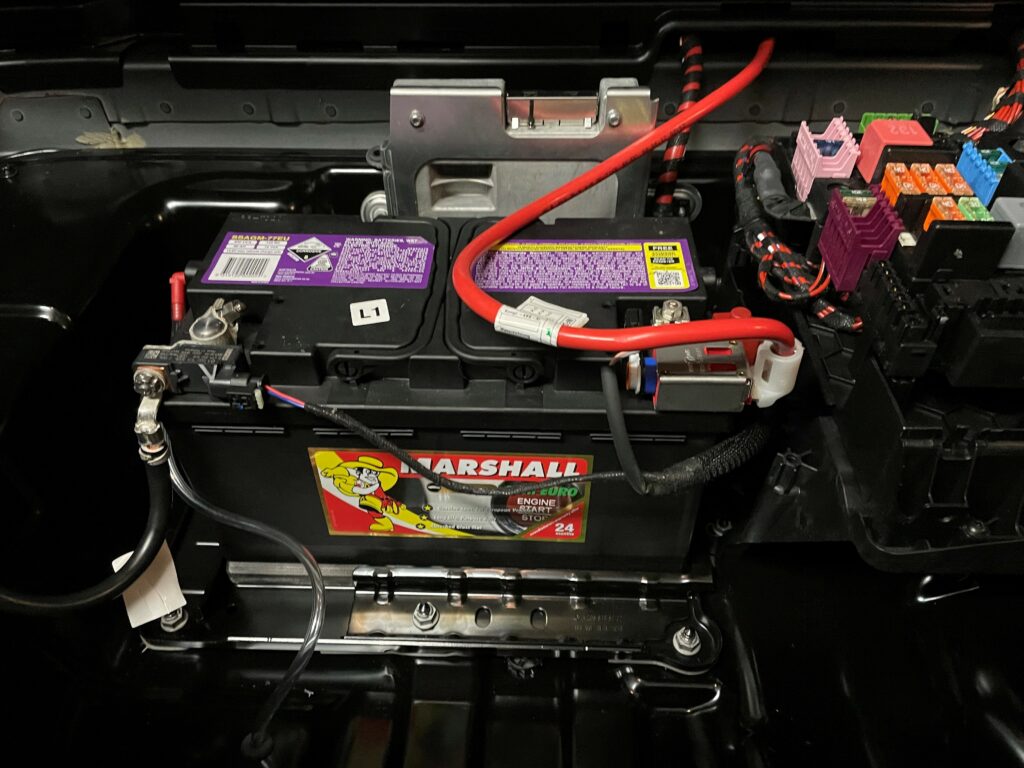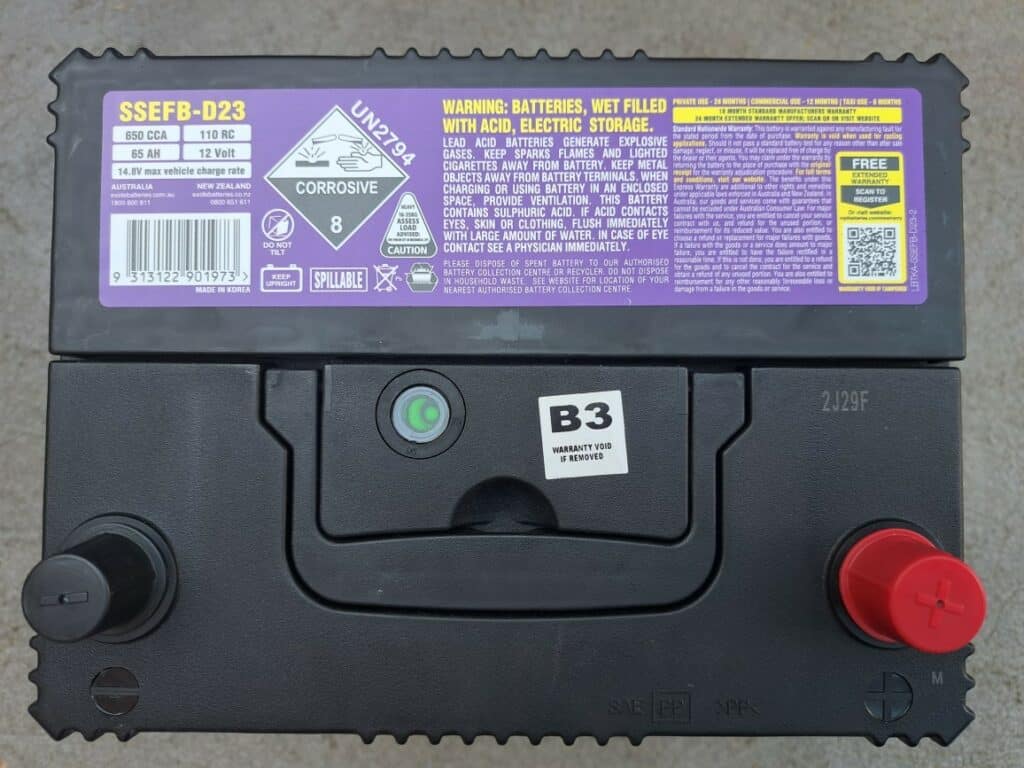
Are you having trouble making sense of the label on your car battery? Don’t worry; you’re not alone!
With so many battery options available, it can be difficult to decide which one is right for your car.
Fortunately, there are some simple steps you can take to understand how to read a car battery label, along with pictures, so you know exactly what to look for.
So let’s get started!
Here is what’s covered,
Table of Contents
What do the numbers on my car battery mean? – Quick Summary

Let’s take a quick look at all the specs displayed on a car battery- If you want an in-depth explanation, click on each spec.
- Cranking Amps (CA): Measures the battery’s cranking ability at 0 degrees Celsius
- Cold Cranking Amps (CCA): Measures the battery’s cranking ability at around -18 degrees Celsius
- Date codes: Two codes are displayed; manufacture date and date of purchase.
- Reserve Capacity (RC): The time a battery will continue to operate essential accessories if the alternator in your car fails.
- Deep Cycle: A 100-hour test of a battery’s ability to resist repeated recharge/ discharge cycles
- Amp Hours (AH): Measure the amount of energy the battery can deliver continuously for 20 hours.
- Group Size: Standardized classification for the battery size, height x width x length and polarity.
There are a bunch of more terms you’ll come across when looking at car batteries online. So, we’ve put together this quick guide that covers all of them.
What do a battery’s different specs mean? A Stupid-Simple Guide
Cranking Amps and Cold Cranking Amps: what’s the difference?
| Cranking Amps (CA) | Cold Cranking Amps (CCA) |
| Measures the battery’s cranking ability at 0 degrees Celsius | Measures the battery’s cranking ability at around -18 degrees Celsius |
Cranking Amps (CA) is the amount of power a battery can provide for starting your vehicle. Cold-cranking amps (CCA) is the same, but at -18°C (0°F).
CCA measures how well a battery will work in cold weather, so if you live in an area with colder climates, you should look for a battery with higher CCA ratings.
Date codes: how old is my car battery?
There are two date codes to look out for in a car battery; the manufacture date and the purchase date for warranty purposes.
Let’s look at them in more detail.
Purchase Date
There should be a rectangular label on the top of the battery with specs.
Usually, at the bottom of this label, you’ll see two lines of circles indicating when the battery was purchased. The first row features the months of the year abbreviated in two letters, while the second row has numbers denoting the year of purchase.
When you buy a battery, the relevant date would be punched out or highlighted, so you will know how long the battery will be in service.
For example, if the label has the letters ‘AU’ and ‘8’ highlighted, it means that the battery was purchased in August 2008.
Manufacture Date – 2 Ways to Check This
There are two options to read the manufacture date on a car battery.
1. Round Sticker
Look for a round sticker that’s usually located on the top or side of your car battery.
It indicates the month and year the battery was manufactured in numeric form. For example, if the round sticker has 8/ 16 on it, it means the car battery was manufactured in August 2016.
2. Heat Stamped Manufacture Date – Quick Chart
Can’t find a sticker or couldn’t read it? Look for an alphanumeric code (containing numbers and letters) that’s heat stamped into the battery’s plastic case.
The first two characters of the code will indicate the original date of manufacture.
Here’s how to crack it,
| Months January |
A |
July |
G |
|
| February | B | August | H | |
| March | C | September | J | |
| April | D | October | K | |
| May | E | November | L | |
| June | F | December | M |
| Years 2010 |
0 |
2016 |
6 |
|
| 2011 | 1 | 2017 | 7 | |
| 2012 | 2 | 2018 | 8 | |
| 2013 | 3 | 2019 | 9 | |
| 2014 | 4 | 2020 | 10 | |
| 2015 | 5 | 2021 | 11 |
For example, if the date stamp on your battery has ‘G’ and ‘5’ as the first digits, you’ll know that the battery was manufactured in July 2015.
Why is it important to know car battery dates?
On average, a car battery will last between 3 to 5 years, provided it is well maintained and correctly installed. Pushing a battery’s usage longer than five years would cause battery failure as the components deteriorate. The dates are provided so you can know when to replace the battery timely.
Check out: How long should a car battery last?
Reserve Capacity – The higher, the better
A battery’s reserve capacity (RC) is the amount of time in minutes it can provide at least 25 amps before its voltage drops below 10.5 volts- this is typically greater than 90 minutes.
The higher the RC, the longer your vehicle will be able to run without needing a charge or jump start.
Deep-cycle refers to how the battery is used. It’s a type of battery designed for sustained discharge over long periods of time, as opposed to short bursts of power.
Deep Cycle
Deep-cycle batteries are commonly used in electric vehicles and solar systems, as they provide the power needed over extended periods.
Deep cycle batteries are typically more expensive than standard car batteries, but they can last longer and be better suited for certain applications.
A deep-cycle battery is probably your best bet if you need a battery that can handle long periods of use without recharging.
Detailed Guide: What Is A Deep Cycle Battery?
How do I know if my battery is a deep cycle?
Deep cycle batteries have thicker plates and more reserve capacity than standard car batteries.
To determine if your battery is a deep cycle, look for the wording “deep cycle” on the label or check the specs for reserve capacity (RC). Deep-cycle batteries typically have RC ratings of 90 minutes or more.
Amp Hours (AH)
Measure how much current a battery is capable of delivering over time. The more amp hours, the longer it will run before needing a recharge.
AH ratings are often used to compare how big one battery is compared to another, as larger batteries tend to have higher Ah ratings (as well as higher price tags).
Voltage Rating: What does 12.1 mean?
12.1 or 12.2 is usually the first number you’ll see on the battery label. This number indicates the battery’s voltage rating, which is how much power it can provide to your car’s electrical system.
The higher the voltage, the more powerful the battery and the longer it will last.
Group Size – Does it really matter?
Group size refers to the physical dimensions of a battery and is usually listed on the label as something like 24F or 65H5.
This number tells you what type of battery you need for your car – make sure to get one that matches the group size in your owner’s manual!
What happens if you put the wrong group-size battery in a car?
Putting the wrong group-size battery in your car can lead to electrical issues, such as a dead battery or difficulty starting the engine.
It can also cause damage to other parts of the vehicle if it doesn’t fit properly. So, yes, size matters!
By understanding all these numbers, you can quickly find a replacement that meets both your needs and vehicle specs.
With this guide, shopping for a new car battery should be easy! Good luck!

